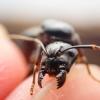So I was wondering if any of you anters out there have found ants that have been scientifically recognized as the same species, yet believe them to be different species. Some of us had discussed the prospects of multiple species of ants living in the North America that are currently under the name Prenolepis Imparis. People in New Jersey have reported 2 different types of P. Imparis which not only differ in their color, one being black, and another being bright orange, but also in their nesting behaviors. Other anters have also taken a step further within this hypothesis of multiple species of P. Imparis by simulating a somewhat natural environment for the breeding and nuptial flights of the imparis queens. It is noted that while the black and orange alates are able to mate and create a fertile colony with workers in the simulated environment, they don't really stick together.
(Although a lot of the information is under the imparis queens, reports of other instances with different "species" are definitely welcome within this discussion!)
I put this topic in General Anting, and I'm not really sure whether it should be in this location or General. I decided since it was about finding these ants and somewhat researching them, it should be in anting. (Might be wrong though)

















